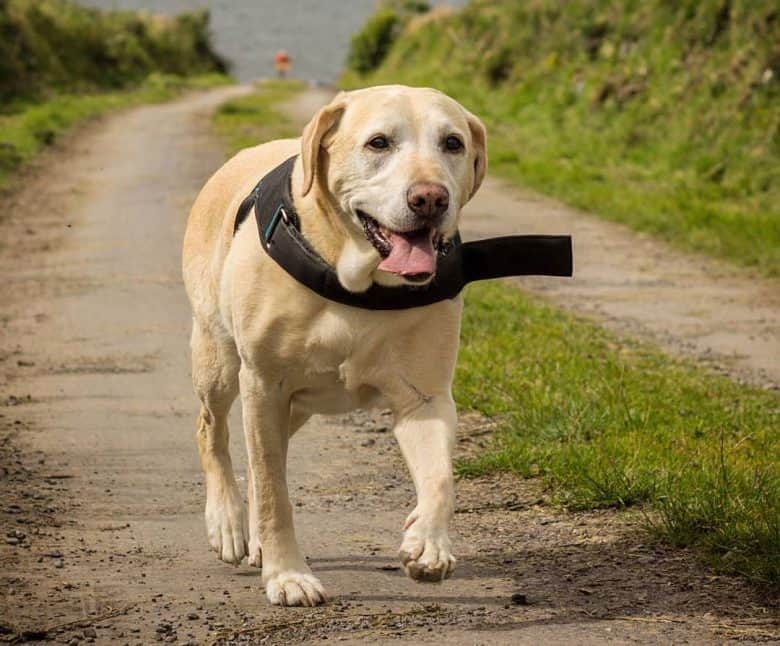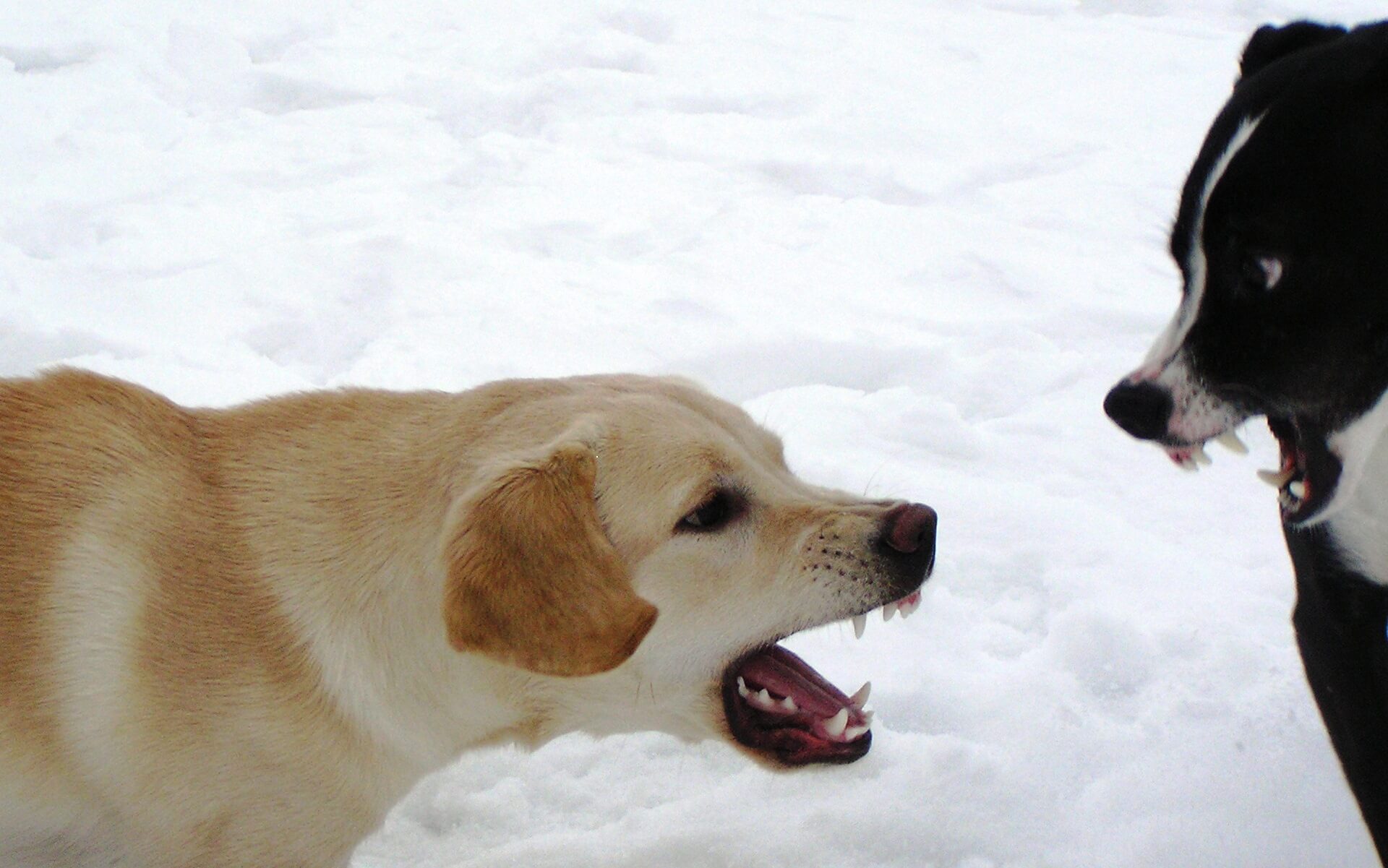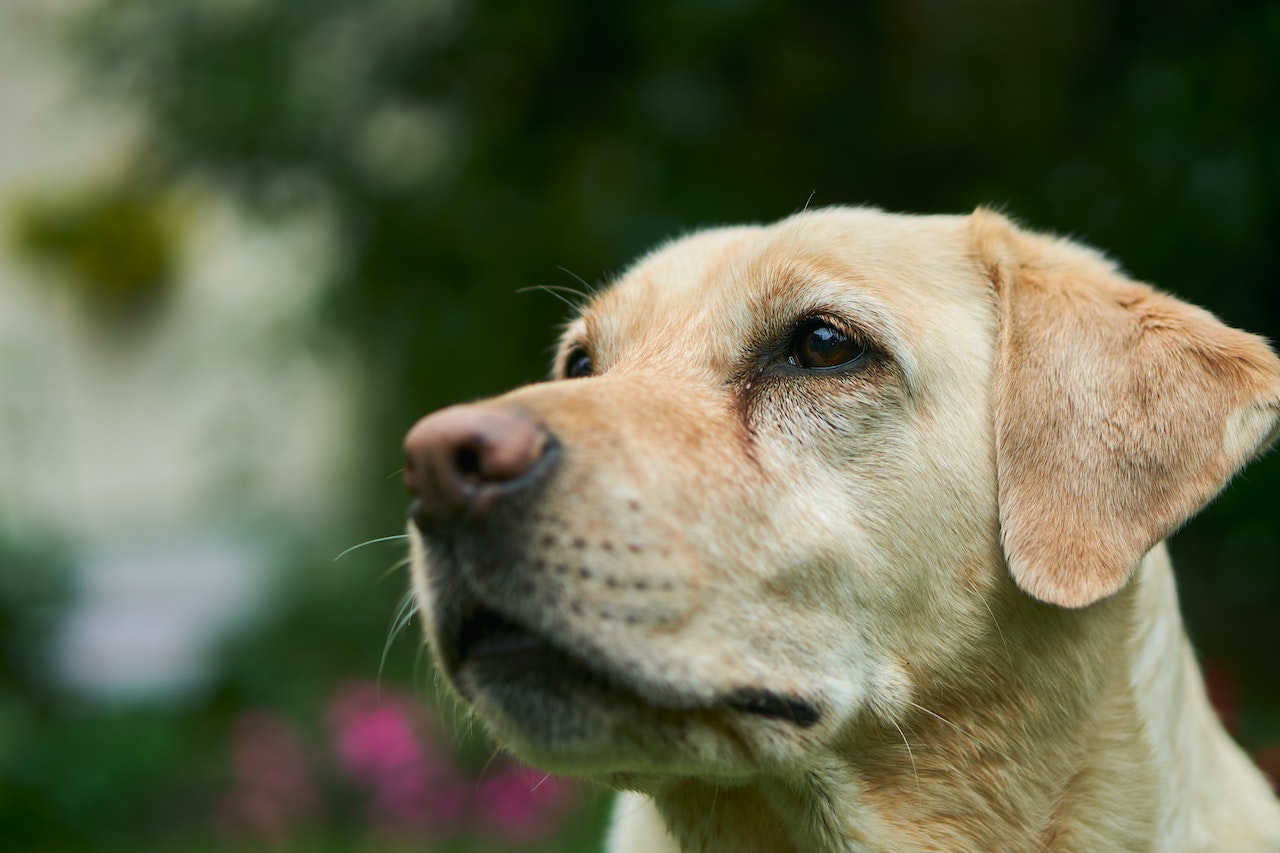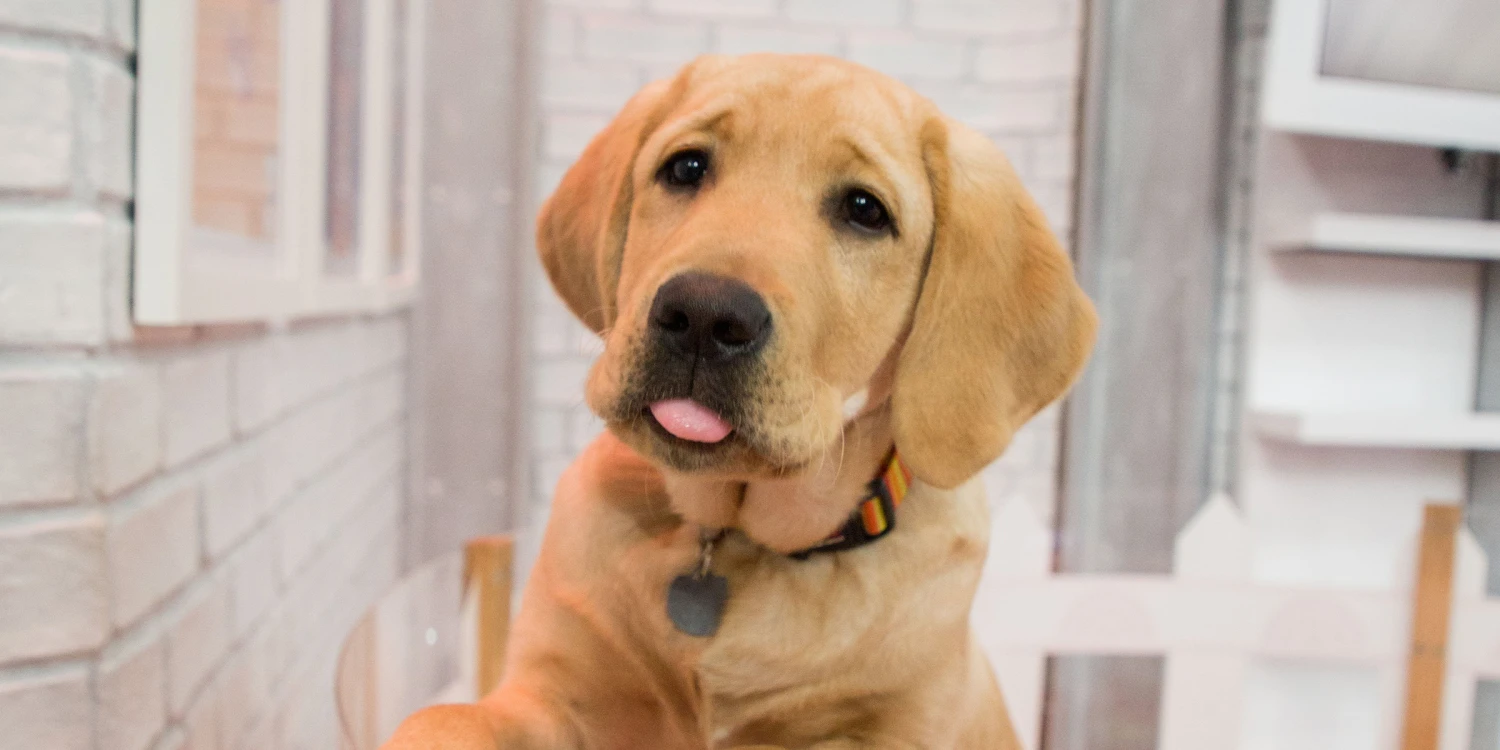Living with an aggressive Labrador can cause stress and upset. Now, we discuss the causes of reactive dogs and what you can do to help them behave better.

Your Aggressive Labrador
Labradors are loved partly for their ability to be social and easy-going dogs. However, it can be difficult to accept that your Labrador is not that way and reacts around other dogs or people.
Other people’s responses can make it more difficult. When you ask them to take their off-lead dog from yours, they won’t believe you. They are very affectionate with everyone. He’ll be fine if you let him go. It’ll help my dog to be yelled at by my family. Do you sound familiar?
The Reactive Labrador
There are Labradors that are reactive and sometimes use aggressive behavior. Although their motivations and reasons for aggressive behavior may vary between Labradors, one thing is constant: aggression is completely normal. All dogs have the ability to display aggression, but it will vary depending on how they are wired and their past experiences. As with humans, dogs can get angry and lose their temper.
The goal of working with reactive and aggressive dogs is not to suppress their aggressive behavior. It is important to increase the dog’s self-control and reduce their need to react aggressively to trigger situations. The likely emotion behind the reactive behavior will determine how we approach it.
Labradors: Warning Signs of Reactivity
Canine social etiquette aims to diffuse tension and avoid conflict. Aggressive behavior is dangerous and should be avoided. Dogs will display early signs of discomfort, such as turning away or moving, yawning, nose-licking, and dilation of pupils. If they don’t get away or they can’t move, they will likely growl or bark more intensely.
Dogs can become frustrated when these less obvious signs are ignored or punished for being unacceptable to humans. Dogs will react to the stronger signals if they learn that they are not being heard or the trigger intensity is too intense.
The handler is responsible for cueing the aggressive behavior shown in the photo below. The handler can see the lack of tension in the dog’s forehead, around his whiskers, as well as the large C of the dog’s mouth and shortened lips. These are just a few signs that the dog is learning. However, I would not advise you to ignore the warning!

Fear Aggression in Labradors
Fear is the main motivation for aggressive behavior in this situation, and it is probably the most prevalent. Fear of approaching dogs or people; fear of their safety; fear of losing something they have; fear that it will hurt.
We can reduce aggression in dogs by changing their feelings. This includes moving from fear to tolerance and encouraging enjoyment or anticipation. It is important to provide pain relief if the dog is in pain.
Frustration can lead to reactivity
Frustration is another common reason for aggression. However, it is often overlooked or misunderstood. Frustrated dogs are more likely to display lower levels of discomfort. However, lip and nose licks can be common when there is conflicted emotion, such as wanting to greet but being unable to do so because of a fence or the lead.
Your Labrador may be frustrated if they keep bouncing on the lead with their ears up, tail raised, tail up and weight forward. They might also bark at other dogs, or act out louder when they have the opportunity to greet. However, frustrated greeters can be socially unacceptable. They may rush at other dogs, ignore any signs that they are not enthusiastic about 30kg of happy Labrador, and end up getting snapped at or worse by the dogs around them.
Dogs who react firstly in frustration can develop fear-based aggression when they are told off by their owners for being socially inept. This can lead to a lot of conflict between dogs.
Dogs that become frustrated with other dogs or are denied certain things may turn their anger on the closest object they can find. This could be the dog’s lead, the dog next to them or a toy. In an emergency, a tug toy or other suitable outlet for frustration-related aggression is one way to manage the situation.
Is Predation a Cause of Reactivity in Dogs?

Predation is a common motivator for aggressive behavior. Labradors have never been associated with preying on prey. It is not uncommon to see Labradors who are excited by fast-moving objects. These include running people, bicycles, and small furry animals.
If the desire to chase is stopped, any aggressive behavior that results may be frustrating, even though predation was the motivation.
What is the medical significance of Reactivity in Dogs?
There are many techniques available to reduce aggressive behavior. It is important to determine if there are any medical issues that could be contributing to aggressive behavior before you consider any of these options.
Pain can be the most obvious reason. If your dog is stiff, hesitant to move, or otherwise uncomfortable, talk with your vet. You can take videos of your dog’s movements, gait, and other concerns so that your vet can identify the exact cause. This will allow them to see what is going on in a way they can not recreate in the clinic. Even if the clinical exam doesn’t identify potential pain, it is possible to try a short pain relief program and observe any changes in behavior.
Dog aggression can also be caused by aggression towards other dogs or their play with them.
There are many medical conditions that can increase aggression, including pain. A thorough vet check is important in case aggressive behavior suddenly develops.
What can you do about reactive dogs?

To ensure safety and security in the short term, it is important to prevent or modify aggression situations for reactive dogs. It helps dogs relax and improves their overall welfare. They are not on edge anticipating what might scare or arouse them. This also prevents them from reverting to the same behavior we wish them to adopt.
Your Labrador’s aggression is a sign that they have strengthened their neural pathways. This makes it more likely that they will continue to react aggressively and can be harder to change. It may become their default behavior and could be used in other situations in the future. It is difficult to change aggressive behavior that has become a habit.
You can help your Labrador avoid reactivity towards other dogs while on walks.
Reacting to Reactivity
It is important that you don’t correct your dog if they react aggressively to any situation.
Calmly take them away from the situation until you can calm them. You can reward calm dogs with treats if they are able to look at the frightening or frustrating thing. You can also help them to learn how to change their emotional responses so the fearful dog is associated with delicious treats.
It takes patience and time to change Labrador’s behavior. The longer they have been reacting, the more difficult it will be for them to adopt new behaviors. Next, we will look at how to change emotions and behavior over the long term.
Why is my dog reactive?
Aggressive behavior is normal in social interactions. Aggressive behavior is a normal part of social interaction.
Sometimes, the dog’s genetic tendency to be anxious, fearful or frustrated or the amount of time they have been practicing aggressive behavior can limit your ability to make progress with them.
It will take patience and the willingness to understand that they may have different needs than you expected when you brought them home. You can still have fun together, but your life might be different.
Know Your Dog

Dog trainers and dog places are becoming more aware of the special needs of sensitive dogs. They offer activities that are suited for dogs who don’t want to play with other dogs or prefer to be in a more open space.
Tracking and scent work are great options. Activity classes offer many different options, including trick training and fun rally.
Reactive behavior can be changed by changing emotions
Any technique should aim to decrease your Labrador’s tendency to be aggressive over an acceptable (to us), a response such as moving away from you or adopting a different behavior. It should be about acknowledging and working with your Labrador to change their emotional response. This is not just about punishing them.
You should also help them learn how to handle arousing situations. This will allow them to make the right decision without you having to direct them. Dogs will need to be taught how to socialize with other dogs. Each Labrador is unique, and each one has their own genetics and experiences. Your behavior modification plan should reflect that fact.
Do not be afraid to ask for help
Expert help is required to support aggressive behavior. Even if your ability to handle the daily behavior modification training on your own is sufficient, it’s worth having someone to give objective feedback and advice about the next steps.
There are many techniques that can be used to change aggressive behavior. These include desensitization and counter-conditioning (DS/CC), differential reinforcement for incompatible behavior (DRI), Behavior adjustment therapy (BAT), Constructional aggression treatment (CAT), ‘teaching dog’, flooding and other methods.
There are many ethical arguments and claims of efficacy (or lack thereof), and there is much debate about them all. However, the most controversial and widely regarded as being effective is DS/CC combined with DRI.
For reactive dogs, desensitization and counter-conditioning
Using DS/CC to help your Labrador fearful will cause him to associate the presence or people of other dogs with the arrival of what he wants. The best choice is often high-value food. This can change his feelings quickly from wanting to see the other dog go to want them to be there so he can enjoy the delicious treat.
DRI is often used to help your Labrador learn appropriate behavior and reinforce polite behavior with other dogs. Your Labrador should always be working from a distance so they aren’t reactive and slowly moving closer to their triggers when they are ready.
Low-level anxiety or fear should be taken seriously and the distance between dogs should be increased until the fearful dog feels at ease. It is dangerous to continue working with dogs above the threshold. This can lead to aggressive behavior.
There are many options to help your reactive dog
One of the biggest criticisms of BAT lies in the way it depends on your Labrador feeling empowered or relieved by another dog’s calm behavior.
This is known as negative reinforcement. The removal of an unpleasant behavior increases the chance of it happening again. This indicates that he was at least slightly uncomfortable before the dog left. Flooding and CAT are extreme examples of using relief as a reinforcer.
Helping him to help himself

In all cases of aggressive behavior, it can help to improve your dog’s ability manage their behavior by using impulse control exercises and creating calm default behaviors. This helps reduce aggression and teaches dogs to change from barking at other dogs to being calm.
This could be as simple as sitting down automatically before the lead goes on or waiting calmly when the car’s boot is opened.
This skill is especially useful in situations of frustration-related aggression, where your Labrador must learn to remain calm when he is denied the things he desires.
It is important to find a trainer who can adapt to your Labrador’s needs. It is important to have faith in your trainer’s ability to use a variety of tools to assess and respond to your Labrador.